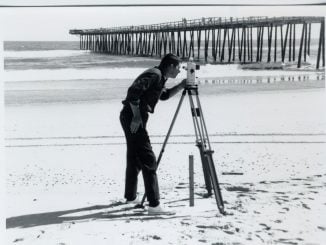An exposed concrete wall at the North Carolina Museum of Natural Science in Raleigh captures a honeybees struggle to belong in our world.The Good of the Hive’s Matthew Willey, a mural painter, is traveling across the country painting honeybee murals to start a conversation about the need for the pollinators.”This is a global, big issue that if we don’t all do a little bit toward it it’s not going to get solved,” Willey said. “I figured people have such a built-in forgetter, like human beings, you move onto the thing. I was like ‘OK, I’m going to use the art and my own career to continuously pulse away.'”Willey aims to paint 50,000 bees in the next decade, a number representing the number of bees in a healthy hive. He is currently rounding the corner of 1,000 bees.North Carolina has become a focal point to begin talking about the survival of honeybees. He has painted murals at Estes Hills Elementary in Chapel Hill, Burners and BBQ in Asheville, Burt’s Bees in Durham and a Carrboro Fire Station.Willey started painting The Good of the Hive murals in March, but he became interested in bees after one flew into his Manhattan studio eight years ago.”I had this connection with this little bee, and then she died,” Willey said. “I had never really thought about bees prior than that more than anyone else, but I put her out in the backyard and I started googling honeybees.”Willey said he came across the struggles of honeybees like colony collapse disorder and also a behavior called altruistic suicide.”The health of a bee is based on the hive,” he said. “When a bee feels sick, it will automatically exit the hive and fly off into the abyss for the good of the hive, which is where the name eventually came from.”Willey said with the paintings, he has seen members of the community talk about the bees, recounting a conversation he had while he was painting the Burt’s Bees mural.He said a man who was about 20 years old who had face tattoos passed him while he was painting at least once a day, and one day he approached him.”He walked up to me, and he just said ‘Nice bees,'” Willey said. “I was like ‘Thanks.’ He said, ‘You know I’ve been watching you paint and me and my mom were talking at the breakfast table this morning about the bees. And we were looking them up online and saw there are a lot going on with them. Then we started talking about what we could do. Then we realized we have a little plot of land in the backyard, so we want to plant some native flowers.'”He said without the mural, the interaction between the two was highly unlikely.”Here I am in this conversation with this 20-year-old guy, who first a 20-year-old guy anywhere is generally not talking about flowers,” Willey said. “We would’ve had a longer conversation if I knew as much as him. I was blown away of how we just connected around this idea a seemingly unlikely connection.”Willey said one of the reasons for painting the murals was to have a natural conversation with communities as opposed to protesting.”It’s just a point of reference,” Willey said. “When you preach stuff at people you’re going to know what I want you to know, it’s not what I do. I look over here. I look at the wall. It’s kind of like the scenes from the movies when someone is standing on a street corner looking up and then somebody else walks up and they’re looking up too, then maybe there is a bee painted on a mural, then you have a group of people looking at the bees, thinking about bees. I don’t have to tell anyone anything.”
Related Articles

Features
History marked
May 22, 1926 Establishment of Great Smoky Mountains National ParkPresident Calvin Coolidge signed a bill establishing the Great Smoky Mountains National Park. The idea to establish the park in North Carolina and Tennessee originated in […]

Features
Entertainment briefs
‘Fate of the Furious’ Rides to Third Straight No. 1 while ‘Latin Lover’ Tops Tom Hanks in ‘The Circle’It has become a familiar story “The Fate of the Furious” is, once again, the box […]

Features
Up, Up and Away!
FUQUAY-VARINA The sky was a kaleidoscope over eastern Wake County for Memorial Day weekend. The annual Freedom Balloon Fest, put on by Project Uplift USA, Raleigh Jaycees and WRAL, welcomed an estimated 80,000 visitors […]
